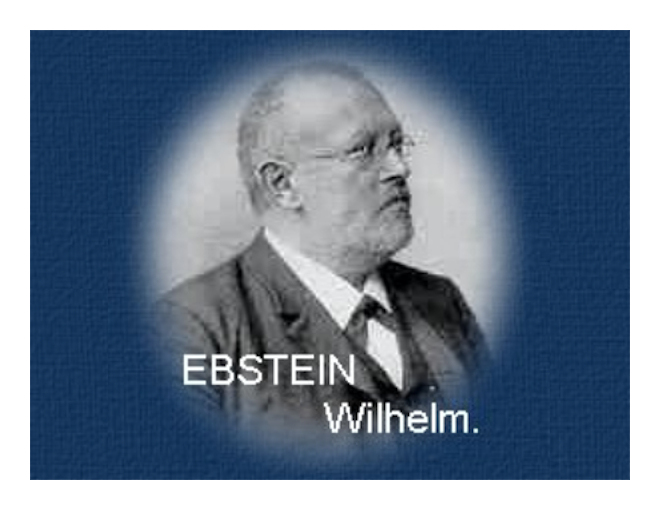Ebstein Wilhelm
Célébrités en cardiologie
(Celebrities in cardiology)

Ebstein Wilhelm © Heart and Coeur ©
 Ebstein Wilhelm
Ebstein Wilhelm
Anomalie d'Ebstein : malformation rare de la valve tricuspide
Johann Christian Andreas Doppler (le 29 novembre 1803 au 17 mars 1853) était un mathématicien et un physicien autrichien célébre pour
Né le 27 novembre 1836 à Jauer (Schlesien); Mort le 22 October 1912 à Goettingen.
Wilhelm Ebstein a étudié à Breslau (1819-1885) et à Berlin (1795-1873).
Il est docteur en médecine le 11 juillet , 1859, et en 1861 obtient une place à l'Allerheiligen-Hôpital à Breslau.
Aprés neuf ans à l'Allerheiligen-Hôpital il est devenu médecin chef au "poorhouse" de la ville (Findelhaus).
En 1874 il est professeur de médecine et directeur de la polyclinic à Gattingen ,
Wilhelm Ebstein est professeur , chercheur, organisateur, mise en place d' une clinique modéle et laboratoires scientifiques.
Il s'est retiré en 1906 et est mort en octobre 1912.
Ebstein a apporté beaucoup de contributions à l'étude des maladies métaboliques;
Les travaux les plus importants étaient "un examen de la maladie du rein" .
En 1887 il a décrit l'état fébrile chronique et récurrent de la fiévre appelée maladie de Hodgkins Pel-Ebstein-Ebstein.
En 1892 il édite le diagnostic des ""Incipient Pericardial Effusions"" et écrit une section sur la maladie rénale dans les maladies séniles, (livre qui a été éditée avec Gustav Albert Schwalbe (1844-1916)).
Ses autres contributions importante sont un livre sur l'obéséité et son traitement (ihre Behandlung d'und de Fettleibigkeit de matrice) et sur le diabéte ...
Ebstein était réputé être un clinicien superbe avec un large cercle d'amis et d'un intérêt vif pour la littérature et les arts .
Son travail pour le conseil de santé de Goettingen lui a donné l'occasion suffisante d'étudier l'hygiéne.
 Ebstein Wilhelm
Ebstein Wilhelm
Ebstein's anomaly
Born in novembre 27,1836, Jauer (Schlesien); died October 22, 1912. Goettingen.
Wilhelm Ebstein studied in Breslau under Friedrich Theodor von Frerichs (1819-1885) and in Berlin under Rudolf Virchow and Moritz Heinrich Romberg (1795-1873). He was conferred doctor of medicine on July 11, 1859, and in 1861 got a position at the Allerheiligen-Hospital (All Saint's Hospital) in Breslau, where, in 1864, he also took over the prosectorate. He was habilitated for internal medicine at the Breslau faculty in 1869. After nine years at the Allerheiligen-Hospital he became chief physician at the city poorhouse (Findelhaus).
In 1874 he was invited to Gaettingen as professor of medicine and director of the polyclinic, and in 1877 also assumed leadership of the medical clinic, succeeding Karl Ewald Hasse (1810-1902), who was forced to resign because of his political views.
Here he excelled as a restless teacher, researcher, organizer, crating a model clinic and scientific laboratories. He retired in 1906 and died in October 1912.
Ebstein made many contributions to the study of metabolic disease; he produced bladderstone experimentally and noticed cylinduria in diabetic coma.
Among Ebstein's most important works was a review of kidney disease in one of the standard medical texts. In 1887 he described the chronic, recurrent febrile condition in Hodgkins disease called Pel-Ebstein fever.
In 1892 he published the article Diagnosis of Incipient Pericardial Effusions and wrote a section on renal disease in the book Senile Diseases which was published with Gustav Albert Schwalbe (1844-1916).
His other contributions of importance were a book Obesity and Its Treatment (Die Fettleibigkeit und ihre Behandlung) which went through 7 editions and another on Diabetes Dietetic Managament.
He wrote on the medical illness of prominent Germans in history, e.g. Luther, Schopenhauer, and medicine in the Talmud and Bible.
Ebstein was reputed to be a superb clinician with a wide circle of friends and a keen interest in literature and the visual arts.
His work for the health council in Goettingen gave him ample opportunity to study hygiene.
source :http://www.whonamedit.com/doctor.cfm/448.html



